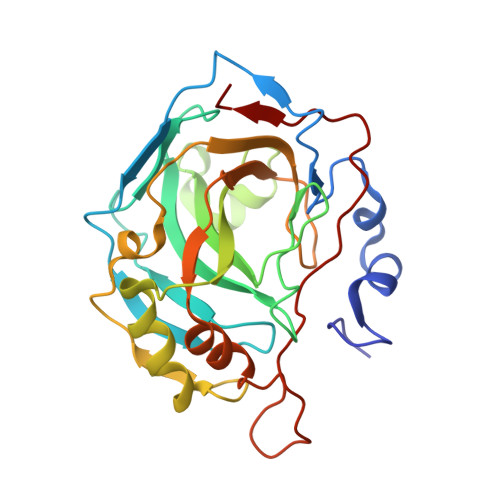First Crystal Structures of Human Carbonic Anhydrase II in Complex with Dual Aromatase-Steroid Sulfatase Inhibitors(,)
Lloyd, M.D., Thiyagarajan, N., Ho, Y.T., Woo, L.W.L., Sutcliffe, O.B., Purohit, A., Reed, M.J., Acharya, K.R., Potter, B.V.L.(2005) Biochemistry 44: 6858-6866
- PubMed: 15865431
- DOI: https://doi.org/10.1021/bi047692e
- Primary Citation of Related Structures:
1XPZ, 1XQ0 - PubMed Abstract:
Carbonic anhydrase (CA) catalyzes the reversible hydration of carbon dioxide to hydrogen carbonate. The role of CA in maintaining pH balance has made it an attractive drug target for the treatment of cancer, and it has recently been implicated in the delivery of sulfamate-containing drugs. With the acceptance of steroid sulfatase as a target for hormone-dependent cancer, novel dual aromatase-steroid sulfatase inhibitors (DASIs) containing a sulfamate group are now being developed. In this study, we show that CA II is potently inhibited by several members of this class of inhibitor. The structures of CA II complexed with 4-[(4-O-sulfamoylbenzyl)(4-cyanophenyl)amino]-4H-[1,2,4]triazole (K(D) = 84 +/- 5 nM) and 4-[(3-bromo-4-O-sulfamoylbenzyl)(4-cyanophenyl)amino]-4H-[1,2,4]triazole (K(D) = 454 +/- 29 nM) are reported to 2.02 and 1.76 A, respectively. Both inhibitors ligate to the active site zinc(II) atom via their sulfamate nitrogen, while the rest of the molecule is contained within the hydrophobic binding pocket. Key protein residues include Val-121, Phe-131, Val-135, Val-143, Leu-141, Leu-198, Pro-202, and Leu-204. Despite being structurally similar, the two ligands experience different types of binding particularly in the sulfamate-containing aromatic ring and the opposite geometric arrangement of the triazole and cyanophenyl groups around the configurationally invertible central nitrogen atom. Small changes in inhibitor structure can cause large changes in binding to CA II, and this underlines the importance of structure-based drug design with this enzyme and other isoforms relevant to potential anticancer therapy. Moreover, these results underpin the idea that binding to erythrocyte CA II may be a general method of stabilizing and delivering sulfamate-based drugs in vivo.
Organizational Affiliation:
Medicinal Chemistry, Department of Pharmacy and Pharmacology, University of Bath, Claverton Down, Bath BA2 7AY, United Kingdom. M.D.Lloyd@bath.ac.uk
















